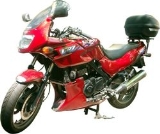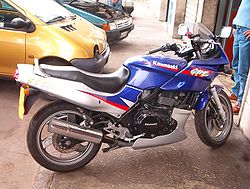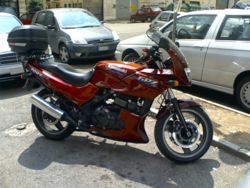
Kawasaki Ninja 500R
Encyclopedia
The Kawasaki Ninja 500R (which was originally named, and is still referred to as the EX500 and is known as the GPZ500 in some markets) is a sport bike
with a 498 cc parallel-twin engine manufactured by Kawasaki from 1987 to 2009, with a partial redesign in 1994. Although the motorcycle has a sporty appearance, it offers a more standard, upright riding position with greater comfort and versatility. It provides a combination of performance and low operating costs, which has made it a favorite as a first motorcycle with new riders and popular with experienced riders on a budget. 2009 was the last model year for the Ninja 500.
For touring the EX500 has an 18 l (38 US pt) fuel tank, reserve included.
Given that it was Kawasaki's best-selling sporty bike for a number of years, the EX500 is a popular mount for road racing, offering low price and availability of spare parts. It also offers a wide but forgiving performance envelope suitable for new riders or even veteran club racers, eschewing the significantly higher expense of campaigning 600 cc or larger supersport machines. The Production Twins class of the LRRS racing organization in New Hampshire comprises primarily essentially stock EX500's. The United States Classic Racing Association has a similar class.
Its marketing name was changed in 1994 from EX500 to Ninja 500; the R suffix was added in 1998. In Europe it was sold as the GPZ 500.
 A partial redesign of the 500 was done in 1994. The changes made include the following:
A partial redesign of the 500 was done in 1994. The changes made include the following:

Motorcyclist magazine for 1994-2009
Motorcycle Consumer News 2004
In February 1992, Cycle World
magazine, in an article titled "Bargain Blasters," compared the EX500 to the Yamaha Seca II, the Suzuki Bandit
, and the Suzuki GS500
. The Seca II came in first, with the Bandit, the EX500, and the GS500 following in that order.
In April 1994, in an article titled "Bargain Hunters," Cycle World compared the then-new Ninja 500 to the Suzuki GS500E
, the Suzuki Katana 600, the Yamaha FZR600, and the Yamaha Seca II. Cycle World concluded of the EX500, "it's our pick as the best overall deal in this group," though each bike had its virtues.
The 2000 Ninja 500 has been reviewed online at motorcycle.com.
The 2004 Ninja 500R was reviewed and compared with the Suzuki GS500 by Motorcycle Consumer News.
Sport bike
A sport bike, also written as sportbike, is a motorcycle optimized for speed, acceleration, braking, and cornering on paved roads, typically at the expense of comfort and fuel economy in comparison to less specialized motorcycles...
with a 498 cc parallel-twin engine manufactured by Kawasaki from 1987 to 2009, with a partial redesign in 1994. Although the motorcycle has a sporty appearance, it offers a more standard, upright riding position with greater comfort and versatility. It provides a combination of performance and low operating costs, which has made it a favorite as a first motorcycle with new riders and popular with experienced riders on a budget. 2009 was the last model year for the Ninja 500.
For touring the EX500 has an 18 l (38 US pt) fuel tank, reserve included.
Given that it was Kawasaki's best-selling sporty bike for a number of years, the EX500 is a popular mount for road racing, offering low price and availability of spare parts. It also offers a wide but forgiving performance envelope suitable for new riders or even veteran club racers, eschewing the significantly higher expense of campaigning 600 cc or larger supersport machines. The Production Twins class of the LRRS racing organization in New Hampshire comprises primarily essentially stock EX500's. The United States Classic Racing Association has a similar class.
Its marketing name was changed in 1994 from EX500 to Ninja 500; the R suffix was added in 1998. In Europe it was sold as the GPZ 500.
Features (1994-2009)

- bigger 17-inch wheels with wider tires replaced the original 16 inch wheels
- redesigned front and rear fairing
- redesigned instrument cluster and dials
- new rear disk brake replaced rear drum brake
- firmer suspension tuning
- minor changes to the engine to improve reliability such as changes to the alternator and cam chain tensioning system
Specifications

Engine
- type: liquid-cooled four-stroke, counter-balanced, 8-valve, dual chain-driven overhead camshaft 180° parallel twin
- displacement: 498 cc
- bore x stroke: 74.0 x 58.0 mm (2.913 x 2.283 in)
- compression ratio: 10.8:1
- redline: 11,000 rpm
- power: 59.1 bhp @ 9,500 rpm (103 hp/L)
- torque: 30.86 foot-pounds (41.8 N·m) @ 8,000 rpm
- starting: electric
- carburetion: Keihin CVK34 x 2
- exhaust: 2-into-2
- ignition: transistorized, battery-powered, inductive, magnetically triggered (1987–1993), TCBI with digital advance (1994-2009)
- oil capacity: 3.6 US qt (3.4 L)
- fuel: unleaded or low-lead minimum octane 91 RON (~87 R+M/2)
Transmission
- six-speed
- constant mesh
- wet-clutch
- final drive: primary drive: 23/61, 2.652
- final drive: 42/16 sprockets (2.625 ratio)pre 1994, 41/16 sprockets (2.5625 ratio) 1994–2006, #520 chain
- gear ratios (transmission) (1) 36/14, 2.571 (2) 32/18, 1.78 (3) 29/21, 1.38 (4) 27/24, 1.12 (5) 25/26, 0.96 (6) 23/27, 0.85
- gear ratios (overall) (1) 17.87 (2) 12.37 (3) 9.60 (4) 7.83 (5) 6.88 (6) 5.92
- maximum speed in gears @ engine redline (1) 44 mph (2) 63 mph (3) 82 mph (4) 101 mph (5) 118mph (6) 138 mph
Chassis
- frame: high-tensile steel double-downtube, full cradle, steel, perimeter box section; steel swingarm
- overall length: 83.66 in (2125 mm) (1987), 83.07 in (2110 mm) (1988–1993), 82.5 in (2096 mm) (1994-2009)
- overall width: 26.97 in (1987–1993), 27.6 in (1994-2009)
- overall height: 45.86 in (1987–1993), 45.7 in (1994-2009)
- wheelbase: 56.5 in (1435 mm)
- ground clearance: 4.9 in (1987–1993), 4.7 in (1994-2009)
- seat height: 30.81 in (770 mm) (1987–1993), 30.5 in (1994-2009)
- dry weight: 373 lb except California (169 kg) 374 lb (170 kg) (1987–1993), 388 lb (1994-2009)
- wet weight: 409 lb (185 kg) (1987–1993), 437 lb (198 kg) (1994-2009)
- fuel capacity (main/reserve): 4.2/0.6 US gal (15.9/2.21 L)
- load capacity (GVWR less curb weight): 418.5 lb (189.8 kg)
Suspension
- rake / trail: 27.5°/3.5 in (89 mm) (1987–1993), 27°/3.6 in (91 mm) (1994-2009)
- type, front: center-axle hydraulic telescopic 36 mm (1987–1993) or 37 mm (1994-2009) fork
- type, rear: UNI-TRAK system with single shock, adjustable pre-load
- wheel travel, front: 5.5 in (140 mm) (1987–1993), 5.1 in (1994-2009)
- wheel travel, rear: 3.9 in (100 mm)
- wheel, front: cast, 2.15 in x 16 in tubeless (1987–1993), 3 x 17 in (1994-2009)
- wheel rear: cast, 2.5 in x 16 in tubeless (1987–1993), 3.5 x 17 in (1994-2009)
- tire, front: 100/90-16 in 54H Bridgestone Excedra G533 (1987–1993), 110/70-17 tubeless (1994-2009)
- tire, rear: 130/90-16 in 83H Bridgestone Excedra (1987–1993), 130/70-17 tubeless (1994-2009)
Brakes
- front: dual-piston hydraulic single (280 mm 1994-2009) disc (SOME GPZ500s versions have a dual disc front brake)
- rear: rod-actuated, single leading-drum (1987–1993), single-piston hydraulic single disc (1994-2009)
Electrical
- battery: 12 V, 14 A·h, type 14LA2 (compatible models: Yuasa YB14L-A2, Varta 514011014, Power Max 12N14-3A)
- power source: AC Alternator, charge control solid-state voltage regulator
- headlight beams (high/low): 60/55 W
- tail/stoplights: 8/27 x 2 W
- instrumentation: speedometer, odometer, single (1987–1993) or double (1994-2009) tripmeter, tachometer with 11,000 rpm redline, water temperature gauge, indicators: oil pressure, high-beam, headlight off, turn signals, neutral
- alternator output:
- Alternator rated output: 17A x 14V DC @ 6,000RPM (calculated 238 watts @ 6000RPM)
- DC Battery Charging Voltage: 14-15V @ 4,000RPM
- Alternator output Voltage: 46-64V AC @ 4,000RPM
- Stator Coil resistance: 0.37-0.46 Ohms
Performance
Cycle magazine January, 1987 for 1987–1993- Standing start ¼ mile: 12.73 s @ 102 mph
- Acceleration, 0-60 mph: 3.76 s
- Acceleration, 45-70 mph, top gears: (4) 4.08 s, 343 ft. (5) 5.92 s, 492 ft.(6) 6.62 sec., 589 ft.
- Braking, 60-0 mph: 115 ft.
- Power @ 60 mph: 9.58 hp
- Engine speed @ 60 mph, top gear: 4,935 rpm
- Average fuel consumption rate 48 mpg (20.4 km/L)
- Cruising range (main/reserve) 202/29 mi. (325/46 km)
- Speedometer error: 30 mph indicated, actual 29.50; 60 mph indicated, actual 57.53
Motorcyclist magazine for 1994-2009
- Standing start 1/4 mile: 12.98 s @ 99.0 mph
- Average fuel consumption: 48.5 mpg
- Average touring range: 233 miles (375 km)
Motorcycle Consumer News 2004
- Top speed: 110 mph (49.2 m/s)
Comparative and Individual Reviews
The EX500 and Ninja 500 have been reviewed by motorcycle magazines, separately and in comparison to other motorcycles, from time to time. Upon its introduction, the EX500 was reviewed in the January 1987 issue of Cycle magazine. With a manufacturer's suggested retail price, as of October 1, 1986, of $2899, the EX500 led Cycle to pronounce, "[o]n price alone, the EX is peerless."In February 1992, Cycle World
Cycle World
Cycle World is a motorcycling magazine in the United States. It was founded in 1962 by Joe Parkhurst, who was inducted to the Motorcycle Hall of Fame as "the person responsible for bringing a new era of objective journalism" to the U.S. and is now the largest motorcycling magazine in the world...
magazine, in an article titled "Bargain Blasters," compared the EX500 to the Yamaha Seca II, the Suzuki Bandit
Suzuki Bandit Series
The Suzuki Bandit is a series of standard street motorcycles produced by Suzuki.The following different models of the bike have been manufactured:* GSF250 with 250 cc...
, and the Suzuki GS500
Suzuki GS500
The Suzuki GS500 is a popular entry level motorcycle manufactured by the Suzuki Motor Corporation. Suzuki produces two forms of the bike; the GS500 or GS500E from 1989 onwards and the fairing model GS500F from 2004 onwards....
. The Seca II came in first, with the Bandit, the EX500, and the GS500 following in that order.
In April 1994, in an article titled "Bargain Hunters," Cycle World compared the then-new Ninja 500 to the Suzuki GS500E
Suzuki GS500
The Suzuki GS500 is a popular entry level motorcycle manufactured by the Suzuki Motor Corporation. Suzuki produces two forms of the bike; the GS500 or GS500E from 1989 onwards and the fairing model GS500F from 2004 onwards....
, the Suzuki Katana 600, the Yamaha FZR600, and the Yamaha Seca II. Cycle World concluded of the EX500, "it's our pick as the best overall deal in this group," though each bike had its virtues.
The 2000 Ninja 500 has been reviewed online at motorcycle.com.
The 2004 Ninja 500R was reviewed and compared with the Suzuki GS500 by Motorcycle Consumer News.
External links
- Three for Five: Budget Bombers - Motorcycle.com comparison test

